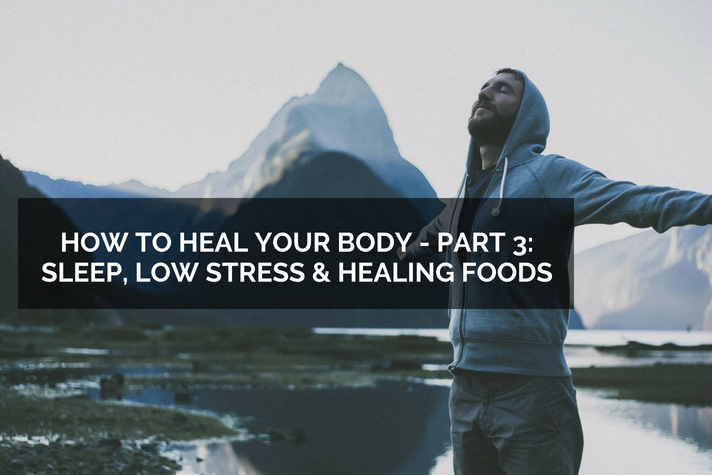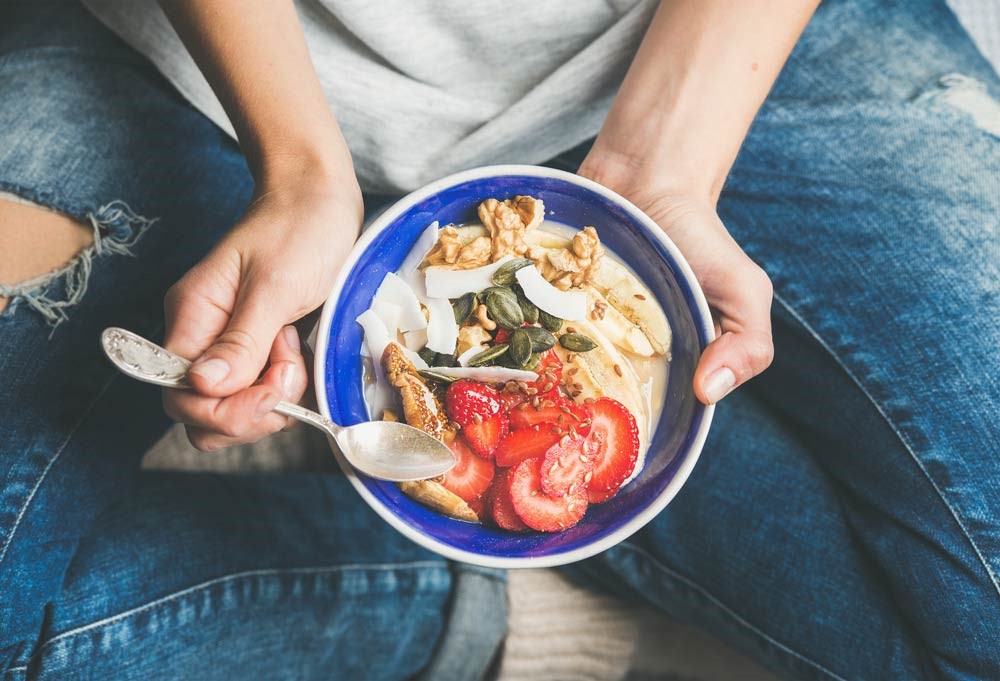
This final Secret Strategies installment covers three strategies that reveal the importance of sleep, low-stress levels and ‘healing foods’. These three strategies can aid in maximising the success of your treatment and recovery process.
8) Improve your sleeping habits
 To improve your sleeping habits, I recommend that you:
To improve your sleeping habits, I recommend that you:
- Reduce your exposure to artificial light in the hours before going to bed by avoiding television and minimise screen time (phones, computers, tablets)
- Aim to get into bed by 9 pm (read or relax) and fall asleep by 10 pm
- Sleep until 6 am or later if possible
The importance of quality sleep is underestimated when it comes to both health and healing. When compared to ancient civilisations, the average person living in a modern developed country today experiences greater overall stress. Therefore, more rest (8-10 hours) and more sleep (6-8 hours) are needed to maintain the same level of health and vitality.
One study found that on average shift workers were sick for more extended periods than day workers. It also found that significantly more shift workers compared to day workers consulted the occupational health services for gastrointestinal complaints. These complaints were on average more severe. This study also found that the incidence of skeletal diseases were more prominent in shift workers.
Another study supported the claims of a higher incidence of gastrointestinal disorders in shift workers in addition to finding:
- A rather strong correlation between shift work and coronary artery disease
- A possible relationship between shift work and increased incidence for diabetes
- Substantial evidence to support an association between shift work and pregnancy outcome regarding miscarriage, low birth weight and preterm birth.
- Overall diminished health status
It has been suggested by other studies that sleep deprivation damages muscle physiology and impairs muscle recovery.
A discussion paper by the National Sleep Foundation discussed how research is now revealing that sleep is a dynamic activity, during which many processes vital to health and wellbeing take place. The latest evidence shows that sleep is essential to helping maintain mood, memory, and cognitive performance. Other studies revealed that sleep plays a pivotal role in the normal functioning of the endocrine and immune systems. It also shows that sleep deprivation was associated with a wide variety of serious health problems including obesity, diabetes, hypertension and depression.
So what are the optimal sleep patterns? To answer this question, we can turn a recent 2015 study that looked at how humans slept before the modern era. This study looked at preindustrial societies in Tanzania, Namibia and Bolivia. The study revealed that people within these civilisations had similar sleep parameters to “modern” humans with an average duration of sleep ranging from 5.7 to 7.1 hours per night. They went to sleep several hours after sunset and typically awoke before sunrise.
Several key issues should be discussed in this study when determining how to apply these findings in the modern world. First, sleep period, the times from onset to offset, averaged 6.9 to 8.5 hours. In other words, the people in these civilisations were resting for 6.9 to 8.5 hours per night even if they were only asleep 5.7 to 7.1 hours. During this time they were not watching television, playing on their phone, watching movies or working on their computers. People in these civilisations were not exposed to artificial light during these times as so often occurs in modern civilisation.
Sleep times also increased by one full hour in the winter months most likely due to longer periods of darkness. With electricity now available throughout the modern world, statistics show that sleep times in modern civilisations do not increase during the winter months.
Although sleep times were not significantly longer in these pre-industrial societies compared to modern civilisations, they also did not experience the same levels of prolonged and intense chronic stress that people in modern civilizations are exposed to.
All in all, the evidence is clear that more quality sleep and greater overall rest, will enhance the healing process.
9) Decrease your overall stress levels

Most people are already familiar with the fact that emotional stress can lead to irritable bowel syndrome, headaches, migraines, stomach aches and exacerbations of skin disorders, but might not know that it can also cause other physical complaints and even chronic pain.
It has been documented that a patient’s perception of pain can be influenced by psychological, emotional, cognitive and social factors, as well as learned behaviours.
Stress most commonly refers to the consequences of the failure of the human body to respond appropriately to physical or emotional threats.16 Stress is also a highly subjective experience that can affect people in many different ways.
Stress may lead to raised levels of the hormone cortisol. Prolonged high levels of cortisol can have a negative impact on immunity and may contribute to systemic inflammation. If the immune system is suppressed, then this can have a negative impact on healing.
By focusing on reducing overall stressors in your life, healing from pain and injury may occur faster.
Consider the following options:
- Identify the top three stressors in your life and see if you can make positive changes that may help reduce their impact.
- Don’t take on any new projects at work and delegate where possible during the healing process.
- Ask for help from loved ones for household duties, looking after kids, shopping, cooking or other activities. Free up time for yourself and use this time to rest and relax.
- Sleep is one of the most powerful stress-reduction techniques. Review the information in point eight.
- Stop high-intensity training immediately. If you’re not a competitive athlete, then this should be an achievable goal. It doesn’t mean stop moving; it simply means stop stressing your body from intense activity.
- Exchange high-intensity training for activities that can reduce cortisol and stimulate the parasympathetic (rest and digest) nervous system.
- Go for a slow walk every day
- Participate in a gentle Yoga, Tai Chi or Qigong classes
- Practice meditation
- Practice mindfulness techniques with Apps such as ‘Headspace’ and ‘Calm.’
- Bounce gently on a rebounder to stimulate the lymphatic system
- Adopt optimal postures in both sitting and standing
- Take ten deep (diaphragmatic) breaths every hour
10) Start consuming ‘healing’ foods.

Some great healing foods include:
| Garlic | Ginger | Turmeric |
| Coriander | Cinnamon | Cayenne |
| Cloves | Nutmeg | Sage |
| Parsley | Blueberries | Liver |
| Onions | Mushrooms | Bone Broth |
The Health Benefits of Ginger
- Aids the digestive process and may alleviate indigestion and flatulence
- Relieves nausea and morning sickness
- Helps relieve the symptoms associated with motion sickness
- Has anti-inflammatory properties that may relieve swelling and pain
- As a tea, ginger can ease headaches and sore throats and can assist with alleviating colds and flu
- Medicinally ginger has been used for asthma, coughs, colic, heart palpitations, swellings, dyspepsia, rheumatism, inhibit vomiting, treat diarrhoea and for strengthening the stomach.
Garlic
In traditional medicine, garlic has been used to cure just about everything! Scientific research has now started to support many of these claims and prove their validity.
There are two main medicinal ingredients in garlic which produce most of the benefits:
- Allicin
- Diallyl Sulphides
Garlic is a sulphurous compound. In general, it is a stronger tasting clove that tends to have more sulphur content and hence more potential medicinal value. Some people have suggested that organically grown garlic has a higher sulphur level and therefore a greater benefit to health.
The Health Benefits
- Garlic can help to promote healthy blood pressure and normal cholesterol levels
- Modern science has demonstrated that garlic is a powerful natural antibiotic, albeit broad-spectrum rather than targeted.
- Garlic, especially aged garlic, can have powerful antioxidant effects. Antioxidants can protect against damaging free radicals. Some evidence suggests that black garlic contains even higher antioxidant levels than normal cloves.
- Some studies have demonstrated that garlic may slow the development of atherosclerosis (hardening of the arteries), a condition that can lead to heart disease or stroke.
- Studies have shown that regular garlic consumption may lower the risk of certain types of cancer such as colorectal cancer.
- Evidence suggests garlic may help prevent the common cold. Fresh garlic has proven more effective than garlic supplements and garlic supplements more effective than placebo.
- It’s important to note that garlic supplements do not seem to have the same health-enhancing benefits as fresh garlic.
The Health Benefits of Parsley
- An outstanding source of vitamin K, vitamin C, vitamin A, folate and iron.
- Parsley’s volatile oils (myristicin, limonene, eugenol and alpha-thujene) have been shown to inhibit tumour formation in animal studies.
- These volatile oils help neutralise particular types of carcinogens.
- Myristicin helps enhance the effectiveness of the powerful antioxidant glutathione.
- The flavonoids (apiin, apigenin, crisoeriol, and luteolin) which are abundantly rich in parsley, have been shown to function as antioxidants by combining with highly reactive oxygen-containing molecules and preventing oxygen-based damage to cells. Also, extracts from parsley have been used in animal studies to help increase the antioxidant capacity of the blood.
- Parsley is a good source of folate, one of the most important B vitamins. While folate has many important roles in the body, one of its most critical roles is relating to cardiovascular health. By lowering homocysteine levels, folate plays a key role in lowering your risk for heart attack and stroke.
- Studies have also shown that folate-rich diets can substantially reduce the risk for both colon cancer and cervical cancer in woman.
- Possibly due to its rich vitamin and mineral content, parsley has been demonstrated to protect against inflammatory joint conditions such as rheumatoid and osteoarthritis.
Beef Liver
If you’re a meat eater, it’s essential to consume meat and organ meats from grass-finished animals (animals that are raised on fresh pasture). Animals should be raised without the use of hormones or antibiotics, and not fed commercial grains or feed. Pasture-raised animal products are much higher in overall nutrients than animal products that come from commercial feedlots.
Studies have shown that meat from pasture-raised animals contains up to four times more omega-3 fatty acids than meat from commercially-raised animals. In addition to the nutritional benefits, organic (biodynamic) animals are treated more humanely. This more humane treatment means it’s better for the earth and benefits the farmers and local communities.
The Benefits of liver
- Some studies estimate that liver has up to 100 times more nutrients than normal muscle meats.
- Gram for gram, liver contains more nutrients than any other food on earth.
- Excellent source of high-quality protein (27g protein per 100g).
- Nature’s most concentrated source of vitamin A
- All the B vitamins are abundant in liver, especially the highly sought after B12
- Liver is an excellent source of folate
- Liver provides an excellent source of iron that is easily assimilated
- Liver contains trace elements such as copper, zinc, manganese and chromium.
- Liver contains an abundance of Co-enzyme Q10, which is very important for cardiovascular health and cognitive function.
- Liver is an excellent source of purines, nitrogen-containing compounds that serve as precursors for DNA and RNA.
- Liver is densely packed with micronutrients, so its consumption supports the entire hypothalamic-pituitary-gonadal axis; this includes both boosting testosterone and reducing estrogen.
- Liver contains vitamins A, D, E, and K.
- Some research suggests that eating liver helps improve the functioning of your own liver, by feeding your liver with all the nutrients needed to detoxify the body.
- In many traditional cultures, organ meats were a prized possession. Liver, heart, brain, kidney and even the blood was recognized as providing the greatest nourishment, far beyond the muscle meats.
Think fruits and vegetables are the kings of micronutrients? Check out this table comparing the specific nutrient values of apples, carrots and beef liver.
| Apple | Carrots | Beef Liver | |
| Biotin | None | 0.42 mcg | 96.0 mcg |
| Calcium | 3.0 | 3.3 | 11.0 |
| Copper | 0.0 | 0.1 | 12.0 |
| Folic Acid | 8.0 mcg | 24.0 mcg | 145.0 mcg |
| Iron | 0.1 | 0.6 | 8.8 |
| Magnesium | 4.8 | 6.2 | 18.0 |
| Niacin | 0.1 | 0.6 | 16.5 |
| Pantothenic Acid | 0.1 | 0.2 | 8.8 |
| Phosphorus | 6.0 | 31.0 | 476.0 |
| Potassium | 139.0 | 222.0 | 380.0 |
| Riboflavin | 0.0 | 0.1 | 4.2 |
| Thiamin | 0.0 | 0.1 | 0.3 |
| Vitamin A | None | None | 53,400 IU |
| Vitamin B12 | None | None | 111.3 mcg |
Conclusion
With the ten steps outlined within the Effortless Superhuman Secret Strategies to health and healing, patients can fast track their healing process and enhance the overall outcome of treatment.
Knowing your body, clearly defining your expectations and being highly-motivated is a crucial first step.
Removing the barriers to healing (such as alcohol, caffeine, processed and other inflammatory foods), can put your body in an optimal state for health and healing.
By reducing your overall stress levels, drinking plenty of high-quality water, and promoting optimal sleep patterns, you give your body the best chance of healing from pain or injury.
And the ‘cherry on top’ is to include nutrient-dense superfoods into your diet that can promote health and healing.
Are you suffering from pain, injury or ill-health?
Do you want to bring out the Genius within your Body?
Do you want to enhance the outcomes of your treatment and fast-track your results?
It’s amazing how often these 10 Secret Strategies to health and healing are overlooked, both by the patient and the treating therapist. And yet these simple strategies are both free and infinitely powerful.
If you’re suffering from chronic pain, niggling injuries or simply not responding to treatment for pain/injury, then empower yourself and begin implementing these 10 strategies today.
To book an appointment with a Effortless Superhuman ‘Pain and Dysfunction’ practitioner contact us today orgive us a call on (08) 9388 2768.
And the ‘cherry on top’ is to include nutrient-dense superfoods into your diet that can promote health and healing.
